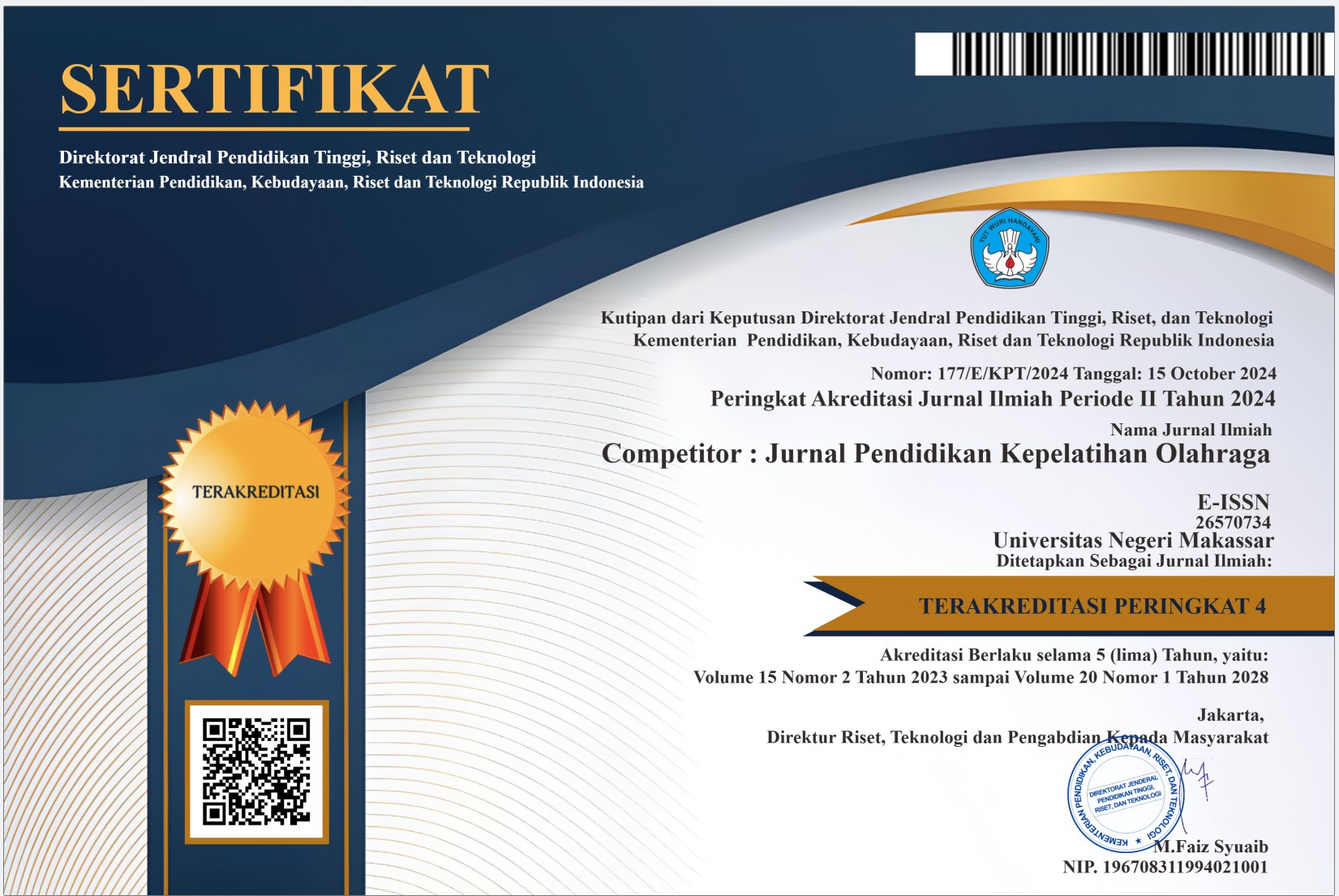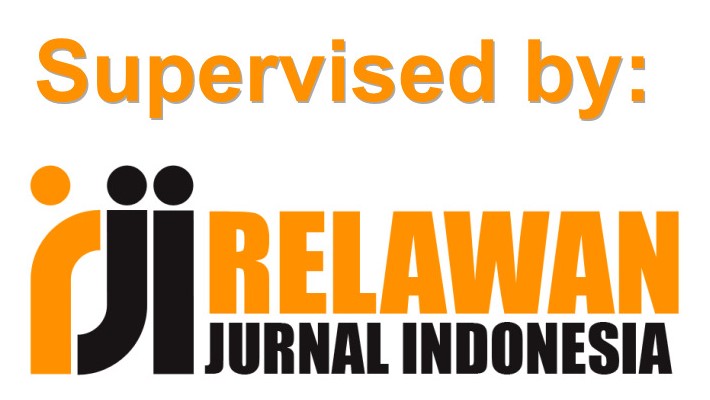The Effectiveness of Vertical Jump Take-Off Angle On Jump Height In 14-Year-Old Basketball Athletes
DOI:
https://doi.org/10.26858/cjpko.v17i2.272Kata Kunci:
Vertical Jump; Push-Off Angel; Jump Height; Basketball.Abstrak
Measurement tests play a very important role in identifying and developing abilities in athletes. The vertical jump test is one part of the measurement test that will be the topic of this study. This study aims to analyze the effectiveness of the push-off angle (90°, 105°, 115°) when performing the vertical jump technique on the jump height. The background of this study is based on the importance of vertical jump ability in basketball, especially for rebounding, blocking, and dunking. Although athletes have good physical condition, many of them do not know the optimal push-off angle that can maximize jump height. This study uses a descriptive quantitative method with a cross-sectional research design. The sample in this study was Castle Warrior KU-14 basketball athletes. The results of this study showed that the average jump height at a 90° angle was 57.25 cm, at a 105° angle of 58.33 cm, and at a 115° angle of 57.17 cm. The ANOVA test showed a significance value of 0.987 (> 0.05), which means that there was no statistically significant difference between the three push-off angles. However, descriptively, the 105° angle gave the highest jump results. This shows that the 105° angle tends to be more effective in producing maximum jumps.
Referensi
Abrar, I. I., & Fitroni, H. (2021). Pembinaan cabang olahraga bola basket pada usia dibawah 20 tahun di Jawa Timur. Jurnal Kesehatan Olahraga, 9(4), 145–154.
Aris, T., & Mu’arifuddin, M. A. (2020). Pengembangan buku ajar bola basket untuk mahasiswa. Jendela Olahraga, 5(2), 62–69.
Baechle, T. R., & Earle, R. W. (Eds.). (2008). Essentials of strength training and conditioning. human kinetics, 1
Budiman, A. F. (2012). Perbedaan Sudut Tolakan Terhadap Nilai power Tungkai. Medikora, 13(1), 1
Budiwanto, S. (2017). Metode Statistika: Untuk Mengolah Data Keolahragaan. Metode Statistika, 1–233.
Clansey, A., & Lees, A. (2010). Changes in lower limb joint range of motion on countermovement vertical jumping. In ISBS-Conference Proceedings Archive.1
Daharis, D., Gazali, N., & Candra, O. (2022). Biomekanika Olahraga.1
Fenanlampir, A., & Faruq, M. M. (2015). Tes dan pengukuran dalam olahraga. Penerbit Andi.57-167
Gunadi, Dwi. (2018). Peran Olahraga Dan Pendidikan Jasmani Dalam Pembentukan Karakter. Jurnal Ilmiah Spirit, 18(3).
Hanusz, Z., Tarasinska, J., & Zielinski, W. (2016). Shapiro–Wilk test with known mean. REVSTAT-statistical Journal, 14(1), 89-100.
Indrawan, J., & Aji, M. P. (2019). Olahraga sebagai Sarana Pemersatu Bangsa dan Upaya Perdamaian Dunia. Jurnal Ilmiah Hubungan Internasional.1
Kiswah, K., Hidayatullah, F., Widodo, H. M., & Himawan, A. (2024). Analisis Biomekanika Terhadap Gerak Lay-Up Mahasiswa Olahraga STKIP PGRI Bangkalan 2022 Menggunakan Aplikasi Kinovea. iyadhoh: Jurnal Pendidikan Olahraga, 7(1), 108–114.
Malik, A. A., & Rubiana, I. (2019). Kemampuan Teknik Dasar Bola Basket: Studi Deskriptif Pada Mahasiswa. Journal of SPORT (Sport, Physical Education, Organization, Recreation, and Training), 3(2), 79–84.
Markovic, G. (2007). Does plyometric training improve vertical jump height? A meta-analytical review. British journal of sports medicine, 349–355.
Naismith, J. (1996). Basketball: Its origin and development. U of Nebraska Press.1
Nugroho, U. (2018). Metodologi penelitian kuantitatif pendidikan jasmani. Penerbit CV. Sarnu Untung.2
Olsen, C., & St George, D. M. (2004). Cross-sectional study design and data analysis. College entrance examination board, 26(03).
Primorezta, R. (2014). Efektifitas Sudut Sendi Lutut Terhadap Kemampuan Daya Ledak Otot Tungkai untuk Tes Vertical Jump. Jurnal Kesehatan Olahraga, 2(3).
Refiater, U. H. (2012). Hubungan Power Tungkai Dengan Hasil Lompat Tinggi. Journal of Health and Sport, 5(03).
Ridha, N. (2017). Proses penelitian, masalah, variabel dan paradigma penelitian. Hikmah. Hikmah, 14(1), 62-70.
Rubiansyah, A., Rusdiana, A., & Mulyana, R. B. (2016). Pengaruh latihan plyometrics terhadap hasil tolakan start pada olahraga renang. Jurnal Terapan Ilmu Keolahragaan, 1(1), 6–11.
Sampaio, J., Gonçalves, B., Mateus, N., Shaoliang, Z., & Leite, N. (2018). Basketball. In Modelling and simulation in sport and exercise, 108–126.
Saputra, S. A. (2020). Menjaga imunitas dan kesehatan tubuh melalui olahraga yang efektif.
Prosiding Seminar Nasional Pendidikan STKIP Kusuma Negara III.1
St L., & Wold, S. (1989). Analysis of variance (ANOVA). Chemometrics and intelligent laboratory systems, 6(4), 259-272.
Sugiyono, P. D. (2024). Buku ajar metodologi penelitian.1-3
Syafruddin, M. A., Jahrir, A. S., & Yusuf, A. (2022). Peran pendidikan jasmani dan olahraga dalam pembentukan karakter bangsa. urnal Ilmiah STOK Bina Guna Medan, 10(2), 73– 83.
Trirahmawati, R., & Wismanadi, H. (2019). PERFORMA DASAR BERMAIN BOLABASKET PADA TIM BOLABASKET PUTRA SMA NEGERI 6 SURABAYA. Jurnal Kesehatan Olahraga, 7(2).
Trudeau, F., & Shephard, R. J. (2008). Physical education, school physical activity, school sports and academic performance. International journal of behavioral nutrition and physical activity, 5, 1–12.
Wisahati, Aan Sunjata, and Teguh Santosa. (2010). Pendidikan jasmani olahraga dan kesehatan. Pusat Perbukuan Kementrian Pendidikan.18
Yusfi, H., & Solahuddin, S. (2020). Teknik pembelajaran keterampilan dasar passing bola basket. Bening Media Publishing 1
Yusuf, F. I., & Rubiono, G. (2018). Analisis Matematis Prediksi Jarak Lompatan Atlet Lompat Jauh Berbasis Sudut Tolakan (Take-off). In Prosiding Seminar Nasional IPTEK Olahraga (SENALOG), 40–44.
Unduhan
Diterbitkan
Terbitan
Bagian
Lisensi
Hak Cipta (c) 2025 Masrizky Edy Pangaksomo, Dita Yuliastrid, Himawan Wismanadi, M. Hijrin Fitroni (Author)

Artikel ini berlisensi Creative Commons Attribution 4.0 International License.





















